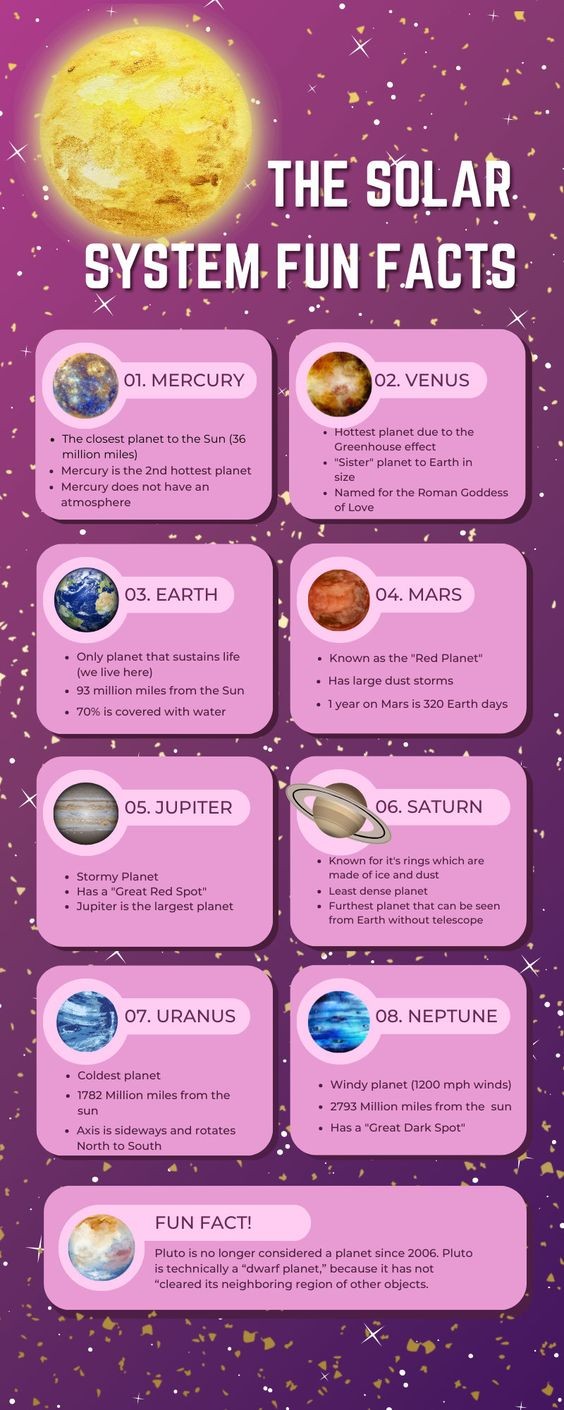Solar System Facts: Infographic Poster
The solar system, our cosmic neighborhood, is a wondrous and intricate assembly of celestial bodies, from the blazing Sun to the icy outer regions.
It’s a place of fascinating diversity and dynamic processes, shaping not only our planet but also our understanding of the universe.
Let's embark on a journey through this extraordinary cosmic realm.
The Sun: The Heart of the Solar System
At the center of our solar system lies the Sun, a colossal star composed primarily of hydrogen and helium.
The Sun’s immense gravitational pull holds the solar system together, its nuclear fusion reactions generating the light and heat essential for life on Earth.
This fiery giant accounts for 99.
86% of the solar system's total mass, its influence extending far beyond the orbit of the outermost planets.
The Inner Planets: Rocky Worlds
Moving outward from the Sun, we encounter the four inner planets: Mercury, Venus, Earth, and Mars.
These terrestrial planets are characterized by their rocky surfaces and relatively small sizes.
Mercury, the closest planet to the Sun, is a world of extremes.
Its proximity to the Sun results in surface temperatures that swing between scorching highs and freezing lows, creating a stark and barren landscape.
Venus, often called Earth's "sister planet" due to its similar size and composition, is shrouded in thick clouds of sulfuric acid.
Its runaway greenhouse effect makes it the hottest planet in our solar system, with surface temperatures hot enough to melt lead.
Earth stands out as the only known planet to support life.
Its abundant water, protective atmosphere, and diverse ecosystems create a unique environment where life thrives.
Earth's dynamic geology, including plate tectonics and a magnetic field, plays a crucial role in maintaining conditions suitable for life.
Mars, the Red Planet, has captivated human imagination for centuries.
Its rusty hue, caused by iron oxide on its surface, hints at a watery past.
Robotic missions have revealed evidence of ancient river valleys and lakebeds, raising tantalizing questions about the possibility of past life.
The Asteroid Belt: A Rocky Divide
Between Mars and Jupiter lies the asteroid belt, a vast region populated by rocky remnants from the solar system's formation.
These asteroids vary in size from tiny pebbles to dwarf planets like Ceres.
The asteroid belt serves as a boundary between the inner, rocky planets and the outer, gas giants.
The Outer Planets: Gas and Ice Giants
Beyond the asteroid belt, we find the outer planets: Jupiter, Saturn, Uranus, and Neptune.
These gas and ice giants are vastly different from their terrestrial counterparts.
Jupiter, the largest planet in our solar system, is a colossal gas giant with a turbulent atmosphere.
Its Great Red Spot, a massive storm system, has raged for centuries.
Jupiter's immense gravity influences numerous moons, including the intriguing Europa, which may harbor a subsurface ocean beneath its icy crust.
Saturn, famous for its stunning ring system, is another gas giant with a complex collection of moons.
Titan, Saturn's largest moon, boasts a thick atmosphere and liquid methane lakes, making it one of the most Earth-like worlds in the solar system.
Uranus and Neptune, the ice giants, are characterized by their bluish hues due to methane in their atmospheres.
Uranus has a unique sideways rotation, while Neptune's dynamic atmosphere hosts supersonic winds.
Both planets have ring systems and moons that continue to intrigue scientists.
The Kuiper Belt and Beyond: The Realm of Ice
Beyond Neptune lies the Kuiper Belt, a region filled with icy bodies, including dwarf planets like Pluto.
The Kuiper Belt represents the remnants of the early solar system, providing clues about its formation and evolution.
Farther out still is the Oort Cloud, a theoretical sphere of icy objects that marks the boundary of our solar system and the beginning of interstellar space.
The Journey of Discovery
Our understanding of the solar system has expanded tremendously over the centuries, from early observations with telescopes to sophisticated space missions.
The exploration of our cosmic neighborhood continues to unveil new mysteries and wonders, driving humanity's quest for knowledge and adventure.
As we journey through the solar system, we gain insights not only into the nature of these distant worlds but also into the origins of our own planet and the potential for life elsewhere in the universe.
The solar system, with its diverse array of celestial bodies, remains a testament to the beauty and complexity of the cosmos, inviting us to explore and discover the unknown.
Conclusion
The solar system is a dynamic and fascinating place, full of wonders that capture our imagination and inspire scientific inquiry.
From the Sun's radiant energy to the icy edges of the Kuiper Belt, each component plays a crucial role in the story of our cosmic neighborhood.
As we continue to explore and study these celestial bodies, we deepen our understanding of the universe and our place within it, embarking on a never-ending journey of discovery.






